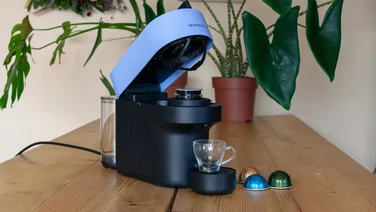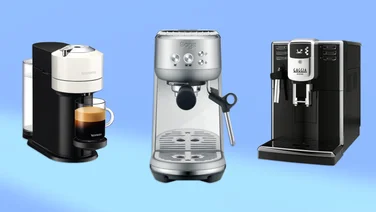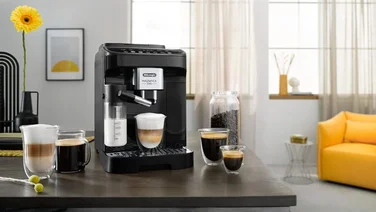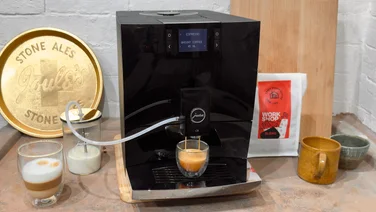To help us provide you with free impartial advice, we may earn a commission if you buy through links on our site. Learn more

- Looks like a KitchenAid
- Heats up quickly for coffee, steam and hot water
- Portafilter design is unique
- Design and build quality
- Fiddly controls
- Makes mediocre espresso
KitchenAid’s appliances have a reputation for blending retro charm with dependable performance, and its latest addition seemingly follows the formula to a T – or rather, to a coffee.
The KitchenAid Artisan 5KES6503 launches the brand into the world of coffee machines with a glossy, compact espresso machine that’s designed to match your existing collection of KitchenAid appliances.
KitchenAid Artisan 5KES6503 review: What do you get for the money?
If you often find yourself lusting after glossy appliances with which to adorn your kitchen worktop, and just so happen to love espresso and espresso-based drinks, then the Artisan just about ticks every box.
It’s available in seven finishes: candy apple red, empire red, stainless steel, medallion silver, almond cream, onyx black and cast iron black. Naturally, the classic KitchenAid profile and prominent logo ensure that everyone knows you’re a true KitchenAid connoisseur.
The specifications are promising. You get a weighty 58mm portafilter – the same size found on more serious-minded espresso machines – and KitchenAid claims that “dual, smart temperature sensors” maintain consistent results from shot to shot. These work in combination with a thermocoil boiler design that promises speedy heat up times, taking less than 45 seconds to reach brewing temperature.
The machine comes with a decent bundle of accessories. There’s a plastic tamper with a heavy metal base, a milk jug, coffee scoop and a selection of pressurised and unpressurised baskets for single and double shots. The only thing missing is a water filter – sadly, this isn’t an aftermarket option, so you’ll just need to reach for your water filter jug instead.
Finally, you get a 1.4-litre water tank, which clips in and out at the rear of the machine, a small slide-out drip tray and a steam wand that slots into the machine’s right-hand side.
READ NEXT: Best coffee cup
KitchenAid Artisan 5KES6503 review: What’s the coffee machine like to use?
Beyond the eye-catching design, it’s easy to see where KitchenAid has focused its efforts: the heavy, metal portafilter is clearly designed to impress, and the bundled tamper has a plastic handle and a heavy metal base. By comparison, similarly priced machines often come with all-plastic tampers and far less substantial portafilters.

The portafilter design is unusual and pretty nifty, too. The combination of a flat base and internal plastic spouts mean that unlike traditional portafilters, which have spouts protruding from the underside, the KitchenAid’s portafilter sits flat on a kitchen surface. This makes it easier to dose with coffee and gives beginners a better chance of producing a nice, flat, tamped puck of coffee.
Look closer, however, and there are signs of needless cost-cutting. The water tank is the first casualty of the penny pinching: it’s made from thin, cheap-feeling plastic and doesn’t clip into place at the rear of the machine as solidly as I’d like. The valve at the bottom of the tank on my review sample had a habit of dripping, too. By comparison, the plastic tanks on Sage’s Bambino machines feel built to last and their sturdier valves don’t drip either.
The steam wand is entirely out of place on a £449 machine. The plain metal wand simply slots into the side of the machine, and isn’t particularly adjustable – it only tilts back and forth or swivels around when you want to add hot water to a cup sitting on the drip tray. Rivals at this price sport robust-feeling wands with far more adjustability, and have proper nozzle attachments for improved control. Crucially, steaming milk is markedly slower than rival machines as well.
Bizarrely, KitchenAid has also cut corners with the portafilter baskets. Despite the welcome presence of a 58mm-wide portafilter, the baskets only have perforations in the central area, something that rather negates the benefit of the larger portafilter. The result is that coffee around the edge of the basket, where there are no holes, isn’t as well extracted as the coffee in the centre – and this impacts on flavour, which I’ll discuss in more detail later.
In basic usability terms, the KitchenAid also falls a little short. Four buttons adorn the front edge, and these are a prime example of form over function. The buttons are needlessly thin and fiddly to press, and the tiny labels and LED lights alongside are too small to read clearly unless you physically bend down to look. The dedicated descaling button is pointless, too – this is not a feature you should need to use very often, and most machines sensibly activate their descaling cycles by holding down multiple buttons instead. By comparison, Sage’s Bambino machines use sensibly proportioned buttons with clear iconography and the fascias are subtly tilted back to ensure they’re easy to see from above.
READ NEXT: Best coffee pod machine
There’s no getting away from the fact that this does not feel like a £449 espresso machine. The quirks of the design and build don’t paint a particularly classy picture and even the operation of the machine feels unduly clunky. Pressing a button can result in a pregnant pause while the machine gets to temperature; there’s only a tiny LED on the display to indicate that something is happening and, once the brewing begins, the machine burbles along with a range of unusually noisy mechanical whirrs and thrums.
The final annoyance? I found the machine leaked water onto our kitchen surface, even when the drip tray indicator wasn’t showing the tray to be full. This may have been due to the leaky water tank valve, or just due to the excessively shallow drip tray – pull the tray out, and even a gentle jolt sends a wave through the water which then spills out the rear. I note that several user reviews have also complained of leaking, so it’s seemingly not an isolated issue. After a couple of initial leaks in the first weeks of testing, I didn’t experience any further leaking, but it’s not something that’s happened with other machines I’ve tested.
KitchenAid Artisan 5KES6503 review: Does it make good coffee?
To an extent, whether it makes a tasty drink or not depends on the coffee, and effort, you put in. If you’re going to be using supermarket pre-ground coffee, then you can slot one of the pressurised baskets into the portafilter and get pouring with a minimum of faff. Just add coffee using the supplied scoop, tamp it down with the tamper and slot it into place – the machine heats up in under a minute, so it doesn’t keep you waiting around.
If you’re dead set on using pre-ground coffee, though, bear in mind that you won’t be getting the most from the KitchenAid – nor any espresso machine for that matter – as there’s a limit to how much flavour you can extract from coffee that’s not fresh or freshly ground. If that’s your plan, I’d advise you buy a cheaper espresso machine such as the De’Longhi Dedica instead.
To give the machine a more thorough workout, I grabbed a few bags of good quality, single origin coffee beans and compared the machine side by side with the £399 Sage Bambino Plus and the £425 Gaggia Classic. The beans were freshly ground using an Iberital MC2 grinder and I took the time to dial in the optimal grind size and dosage, as well as measuring the time taken to produce an exact amount of espresso, just to ensure consistency.

It was a little tricky to get the KitchenAid pouring well to begin with. Despite it having similar-sized baskets to our Gaggia Classic, the KitchenAid choked when I used the same grind size and dosage – the pump whirred noisily and slowed to a drip. It was only once I opted for a far coarser grind that the KitchenAid started to pour more readily and, with a little time and effort, it began to serve up a reasonable espresso.
The taste tests were interesting. While the Sage Bambino Plus has a smaller 54mm portafilter, compared to the 58mm portafilters of the KitchenAid and Gaggia machines, it serves up a very smooth, balanced espresso, albeit one that arguably lacks some of the complex flavours unearthed by more capable (and generally pricier) machines. By comparison, the Gaggia Classic is far more successful at drawing out the rich fruity tang and chocolate notes in the coffees. The KitchenAid tended to be harsher and more acidic than either of its rivals – this was fine in milk-based coffees but espressos were unappetisingly sharp as a result.
READ NEXT: Best Nespresso machine
KitchenAid boasts that the Artisan has a 15-bar pump – a common specification you’ll see bandied about by coffee machine manufacturers – but it’s worth noting that higher pressures don’t actually translate into good coffee, and that may be the issue here. Even if a machine has a pump capable of generating 15 bars of pressure, you want it to brew espresso at roughly 8 bars of pressure to extract the best flavours from the coffee. Higher pressures can bring out too many bitter flavours, while lower pressures, right down as low as 4 bar, can produce wonderfully aromatic shots.
For reference, Sage’s machines tend to brew at around 8 bars, whereas our favourite, the Gaggia Classic, brews a bit higher at around 12 to 13 bars. Even though the Classic does tend to be more flavourful than similarly-priced rivals, the elevated brew pressure explains why the Gaggia can lend a slightly bitter edge to some coffees and, incidentally, this is why some people invest in aftermarket modifications to lower the pressure.
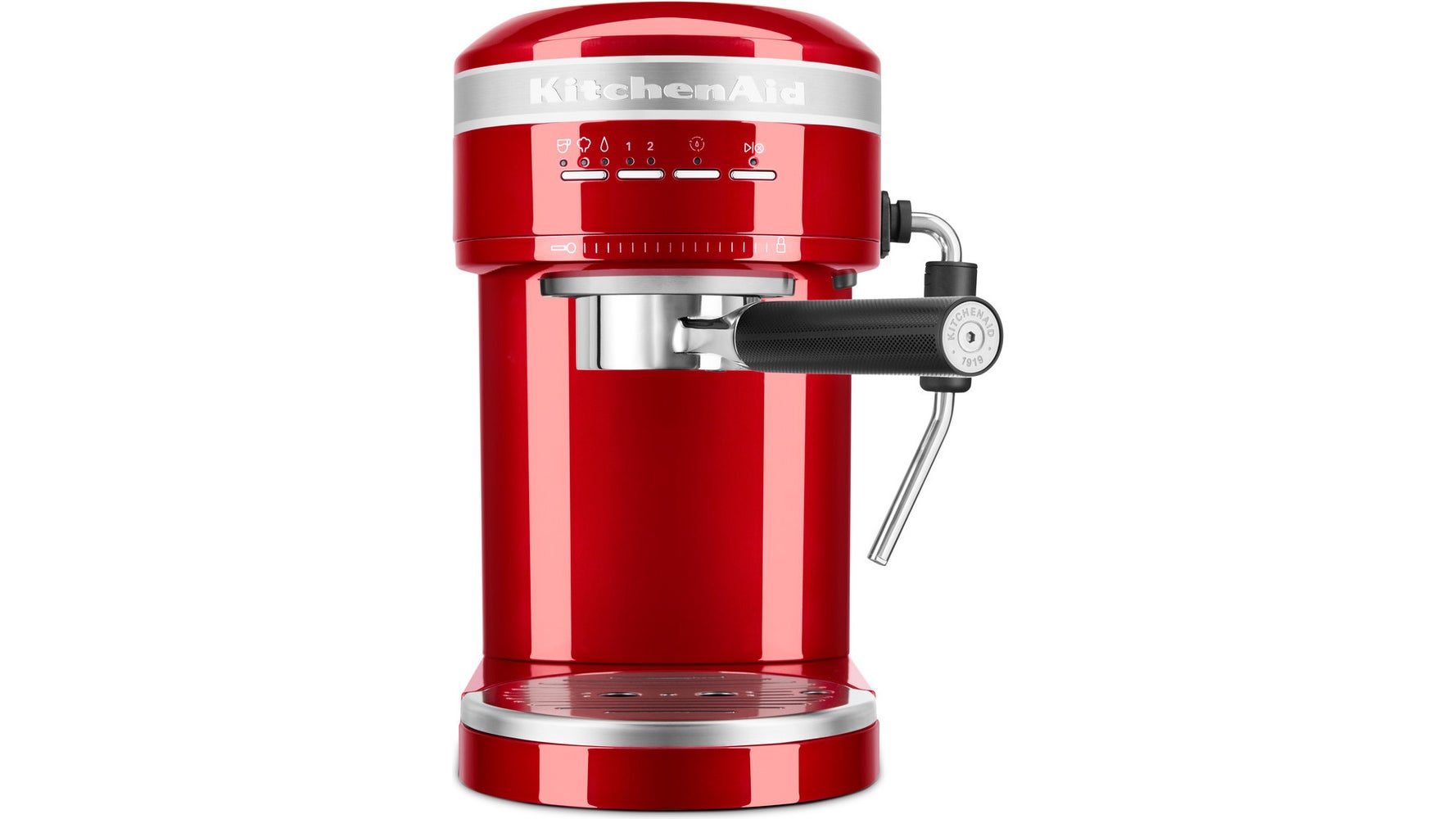
Given the earlier qualms about the KitchenAid’s baskets, and the concerns about brew pressure, I swapped in a good quality aftermarket basket from VST, and the results were noticeably improved. Instantly, I had to make the grind much finer to achieve a nice, steady pour – indicating that the stock baskets were indeed impeding the flow of water – and the shots lost some of their previous harsh, acidic edge. They still weren’t anywhere near as smooth and drinkable as the Gaggia’s efforts, however. The big downside here is that the portafilter now dripped messily, as I’d had to remove its internal plastic spouts to fit the VST basket – as a result, this is not an upgrade I’d recommend.
It’s worth noting that, regardless of the type of basket or coffee you use, the machine does tend to continue to drip for some time after a shot is poured. This is because, like Sage’s cheaper Bambino and other (relatively) inexpensive machines, the KitchenAid lacks a solenoid valve to release the pressure after each shot. This is something the Sage Bambino Plus and Gaggia Classic do have, and it makes for drier coffee pucks and rather less mess between shots.
KitchenAid Artisan 5KES6503 review: Should you buy it?
At its RRP of £449, the KitchenAid Artisan is overpriced. Both the design and interface lack refinement, and the coffee it makes – while consistent – isn’t anywhere near good enough to mask its shortcomings. If you’ve fallen desperately in love with the looks, you’d be advised to wait for some big discounts before spending your money and you’ll still have to wrestle with the knowledge that you could have bought a number of better machines for less cash.
The conclusion is simple. If you want a fully manual machine, buy the £425 Gaggia Classic instead. It might not have niceties such as PID temperature control but it makes great coffee – and it, too, comes in different colours if that’s a key requirement. If, on the other hand, you want a little more hand-holding but still want good espresso, buy the £399 Sage Bambino Plus: with automatic milk texturing, good build quality and impressive attention to detail throughout, it’s superb value.


